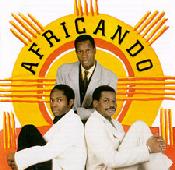 PAPE SERIGNE SECK a giant of African popular music, died of liver cancer in Dakar, Senegal on February 2, 1995. He was a master vocalist, a pioneering musicians' union leader and an irreplaceable keeper of the flame.
PAPE SERIGNE SECK a giant of African popular music, died of liver cancer in Dakar, Senegal on February 2, 1995. He was a master vocalist, a pioneering musicians' union leader and an irreplaceable keeper of the flame.
 Among the singers on hand, Pape Seck and Medoune Diallo (Orchestre Baobab) were elder statesmen of the Afro-Latin movement. The other vocalists were young Nicholas Menheim from Senegal, with Ronnie Baro, Adalberto Santiago and Yayo El Indio representing the New York side.There were also over a dozen of the finest Latin instrumentalists then working, including Sergio George (piano), Jose"Chombo" Silva (saxophone), and Hector "Bomberito" Zarzuelo (trumpet). After an initial summing up on both sides, the musicians coalesced into a team of respectful colleagues and began to enjoy themselves.
Among the singers on hand, Pape Seck and Medoune Diallo (Orchestre Baobab) were elder statesmen of the Afro-Latin movement. The other vocalists were young Nicholas Menheim from Senegal, with Ronnie Baro, Adalberto Santiago and Yayo El Indio representing the New York side.There were also over a dozen of the finest Latin instrumentalists then working, including Sergio George (piano), Jose"Chombo" Silva (saxophone), and Hector "Bomberito" Zarzuelo (trumpet). After an initial summing up on both sides, the musicians coalesced into a team of respectful colleagues and began to enjoy themselves.
Pape Seck was a tall, loosely knit man with a mobile, wide featured face that seemed to involuntarily reflect his thoughts and impulses. A dimple under one eye added a boyish touch, especially when he was contemplating mischief. He developed a terrible cold mid-way through the recordings which did not make the slightest dent in his professionalism. However, he ultimately had to simply talk his solo on the tune "Africando". Amid the swirling feints and jousts of the other five singers his gruff and measured declamation was so unexpectedly effective that the producers left it that way. To my ear, this brief contribution was the fulcrum of that cut. As the flautist Eddie Zervigon of Orquestra Broadway fame observed during the sessions, the man could really sing!
Pape Seck's deep and raspy voice, which has been compared to that of Louis Armstrong, was an improbably agile instrument with horn-like overtones. The contrast between the heft of his timbre and how his art allowed it to ignore gravity often struck me as irresistibly droll. He conveyed a joyous acceptance of human frailty which encompassed more than a passing knowledge of tragedy. His interpretations of darker material seemed to reveal an innocent bewilderment at the random indignities of fate along with a realistic appraisal of his personal duty toward it. Musically or otherwise, his was not a passive presence.
Pape Seck was a convivial sort who enjoyed a good time. After the project wrapped, Stern's U.S. threw a dinner party for the African team. Pape Seck and the other singers got loose and there was much scurrying to and from our host's balcony for photo ops despite the rain. We listened to some early mixes from the sessions. As each vocalist appeared, the whole room shouted his name and applauded. The day before, Mr. Sylla had proclaimed a need for formal photographs of the singers. A wedding photographer on West 72nd street had been hastily drafted to do the honors earlier in the afternoon, so everybody was still dressed to kill. The results of the studio shoot now grace the CD inserts of both volumes of Africando. When the guests left for their hotel, I walked them to the elevator. The moment was liquid as we embraced each other in farewell. That was the last time I saw Pape Seck.
It was obvious from early on that a potent recording was being created, born of an old musical debt, now acknowleged and paid in full by both sides. That Pape Seck took pleasure and pride in the undertaking is clearly audible in every note he sang. It's terribly sad that he should have died so young. Yet it renders still more precious the recorded history that is left in our care, the journey of a soul spilling forth as sound.
Sound sample and graphics used by permission of Stern's US